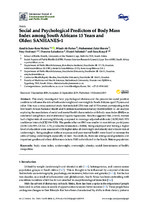Social and psychological predictors of body mass index among South Africans 15 years and older: Sanhanes-1

View/
Date
2019Author
Mchiza, Zandile June-Rose
Parker, Whadi-Ah
Hossin, Muhammad Zakir
Metadata
Show full item recordAbstract
This study investigated how psychological distress and the proxies for social position
combine to influence the risk of both underweight and overweight in South Africans aged 15 years and
older. This was a cross-sectional study that included 2254 men and 4170 women participating in the
first South African National Health and Nutrition Examination Survey (SANHANES-1). An analysis
exploring the associations of social and mental health characteristics with body mass index (BMI) was
conducted using binary and multinomial logistic regressions. Results suggested that, overall, women
had a higher risk of overweight/obesity compared to men (age-adjusted odds ratio [AOR] 4.65; 95%
confidence intervals [CI] 3.94–5.50). The gender effect on BMI was smaller in non-African participants
(AOR 3.02; 95% CI 2.41–3.79; p-value for interaction = 0.004). Being employed and having a higher
level of education were associated with higher risks of overweight and obesity and a lower risk of
underweight. Being single or without a spouse and poor mental health were found to increase the
odds of being underweight, especially in men. To conclude, there are strong social gradients and
important gender and ethnic differences in how BMI is distributed in the South African population.
